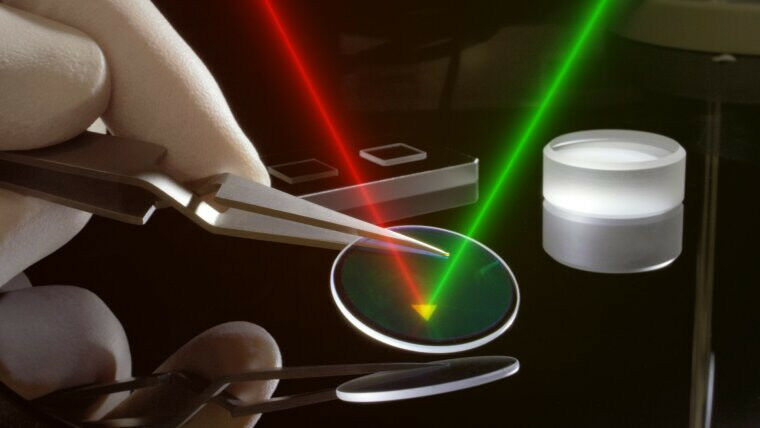博文
量子光学的突破
 精选
精选
||
量子光学的突破
诸平
据德国耶拿弗里德里希·席勒大学(Friedrich Schiller University Jena)2024年9月3日提供的消息,量子光学的突破(Breakthrough in quantum optics)。
由马克西米利安·魏斯弗洛格(Maximilian Weißflog)领导的一个国际研究小组,在来自德国耶拿、澳大利亚堪培拉(Canberra)的研究人员的参与以及德国达姆施塔特(Darmstadt)的研究人员的支持下,在量子光学方面取得了重大进展。该团队在著名的《自然通讯》(Nature Communications)杂志网站2024年9月1日在线发表的最新论文中,提出了一种利用二维材料{two-dimensional (2D) materials}产生纠缠光子对的新方法。这一发展可能为移动设备上的量子加密打开大门。原文详见:Maximilian A Weissflog, Anna Fedotova, Yilin Tang, Elkin A Santos, Benjamin Laudert, Saniya Shinde, Fatemeh Abtahi, Mina Afsharnia, Inmaculada Pérez Pérez, Sebastian Ritter, Hao Qin, Jiri Janousek, Sai Shradha, Isabelle Staude, Sina Saravi, Thomas Pertsch, Frank Setzpfandt, Yuerui Lu, Falk Eilenberger. A tunable transition metal dichalcogenide entangled photon-pair source. Nature Communications, 2024, 15, Article number: 7600. DOI: 10.1038/s41467-024-51843-3. Published: 01 September 2024. https://doi.org/10.1038/s41467-024-51843-3
参与此项研究的有来自德国耶拿弗里德里希·席勒大学(Friedrich Schiller University Jena, Albert-Einstein-Straße 15, Jena, Germany)、德国耶拿的马克斯·普朗克光子学学院(Max Planck School of Photonics, Hans-Knöll-Straße 1, Jena, Germany)、澳大利亚国立大学(The Australian National University, Canberra, ACT, Australia)、德国耶拿的弗劳恩霍夫应用光学与精密工程研究所(Fraunhofer Institute for Applied Optics and Precision Engineering IOF, Albert-Einstein-Straße 7, Jena, Germany)以及德国达姆施塔特工业大学(Technical University of Darmstadt, Hochschulstraße. 6-8, Darmstadt, Germany)的研究人员。
纠缠光子的小型源(Miniaturized source for entangled photons)
论文中提出的纠缠光子对之源非常小:尺寸仅为10×10×10 µm,可以很容易地集成到紧凑的设备中。对于通常体积庞大、处理复杂的传统纠缠光子源来说,这是一个决定性的优势。
可调节的纠缠(Adjustable entanglement)
这种新源的另一个突出特点是它的可调节性。所产生的光子对的纠缠类型可以通过使用泵浦激光器(pump laser)来改变。这种灵活性开辟了广泛的可能应用,特别是在量子通信和量子加密领域。通过提供基于量子力学原理的安全通信通道,移动设备将来可以从这项技术中受益。
国际合作(International cooperation)
这项研究工作是德国耶拿弗里德里希·席勒大学、堪培拉的澳大利亚国立大学以及德国达姆施塔特工业大学之间富有成效的合作的结果。国际研究培训小组(IRTG) 2675“Meta-Active”{ International Research Training Group (IRTG) 2675 "Meta-Active"}的国际合作,强调了实现技术突破的全球科学合作的重要性。
潜在的应用和未来的前景(Potential applications and future prospects)
在如此小的尺度上产生纠缠光子对并具有可调特性的能力,可能对量子计算机和量子通信系统的发展产生深远的影响。特别是对于移动通信和便携式设备,这开辟了一个由于所需技术的规模和复杂性而迄今尚未开发的新领域。这一结果标志着量子光学的实际应用迈出了重要的一步,并可能为未来安全数据传输的发展奠定基础。
下一步的研究目标是通过准相位匹配(quasi-phase matching)来提高生成速率,并将源集成到高Q单片腔中以提高纠缠对生成速率。将这些源集成到光子芯片中也将被探索以开发微型量子密钥分发(quantum key distribution简称QKD)器件(miniature QKD devices)。此外,将研究新型材料和元表面(meta-surfaces)的使用,以创造更明亮、更全能的光源。
这项工作由德国研究基金会(Deutsche Forschungsgemeinschaft简称DFG/German Research Foundation)通过国际研究培训小组(International Research Training Group简称IRTG) {Deutsche Forschungsgemeinschaft (DFG, German Research Foundation) through the International Research Training Group (IRTG) 2675 “Meta-ACTIVE”, project number 437527638}、DFG合作研究中心(Collaborative Research Center简称CRC) 通过MEGAPHONE项目和埃米·纳脱计划{Collaborative Research Center (CRC) 1375 “NOA”, through “MEGAPHONE” project number 505897284 and through the Emmy Noether Program, project number STA 1426/2-1}、德国联邦教育与研究部{Bundesministerium für Bildung und Forschung (BMBF, German Federal Ministry of Education and Research) under the project identifiers 13N14877, 13XP5053A , 16KISQ89}、德国图林根州量子中心{State of Thuringia (Quantum Hub Thüringen, 2021 FGI 0043)}、澳大利亚国立大学博士生奖学金(ANU PhD student scholarship)、澳大利亚研究理事会{Australian Research Council (ARC) grant no. DP220102219, LE200100032}、澳大利亚研究理事会量子计算与通信技术卓越中心{ARC Centre of Excellence in Quantum Computation and Communication Technology (project number CE170100012)}以及欧盟地平线2020研究与创新计划{European Union’s Horizon 2020 research and innovation program under the H2020-FETOPEN-2018-2020 grant agreement no. [899673]}的资助。
上述介绍,仅供参考。欲了解更多信息,敬请注意浏览原文或者相关报道。
Entangled photon-pair sources are at the core of quantum applications like quantum key distribution, sensing, and imaging. Operation in space-limited and adverse environments such as in satellite-based and mobile communication requires robust entanglement sources with minimal size and weight requirements. Here, we meet this challenge by realizing a cubic micrometer scale entangled photon-pair source in a 3R-stacked transition metal dichalcogenide crystal. Its crystal symmetry enables the generation of polarization-entangled Bell states without additional components and provides tunability by simple control of the pump polarization. Remarkably, generation rate and state tuning are decoupled, leading to equal generation efficiency and no loss of entanglement. Combining transition metal dichalcogenides with monolithic cavities and integrated photonic circuitry or using quasi-phasematching opens the gate towards ultrasmall and scalable quantum devices.
https://blog.sciencenet.cn/blog-212210-1449749.html
上一篇:多肽和人工智能揭示药物设计的新途径
下一篇:新研究:怀孕期间吃鱼可降低20%患自闭症的风险
